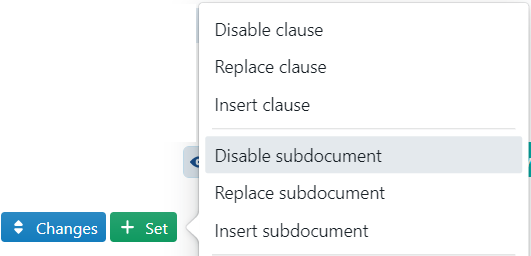There might be circumstances where the presence of a certain subdocument should be conditional. There are two main ways to achieve this:
- Via conditional logic in the enabled? field of a document itself.
- Via the “Disable subdocument” change set in Q&A mode.
1. Via conditional logic
Inserting condition logic into a document is very similar to how you would approach this for a clause. Navigate to binder > properties and click on the subdocument that shall be made conditional.

A new file pops up in the Edit menu, which is where the properties of the subdocument are changed. In the enabled? pane, the file can be enabled or disabled based on a certain condition.
You could use a general condition like #share-transfer-agreement^consent-letter-applicable = true to activate or deactive the Annex Form of Consent Letter (see screenshot above). Just fill it out, hit save and the datafield for this condition should be visible under the “Datafields” menu.
You could also make the inclusion of a subdocument conditional on whether or not a clause is included in the binder somewhere (i.e.: whether a concept or cross-tag has been implemented). Thus, we need to use the special function @implemented to create this condition. For example:
- To make a document conditional on the inclusion of a clause that implements the concept of #confidential-information, use @implemented(#confidential-information)
- To make a document conditional on the inclusion of a clause that has a crosstag by the name of “confidential-information”, use @implemented(confidential-information)
For a more detailed overview of cross-references, please consult this article and this How To.
2. Via change set in Q&A mode
Create a Disable subdocument change set for your Q&A by going to the Changes panel and clicking “Disable subdocument”.

Then, simply choose the document that needs to be disabled under a given circumstance and attach a condition to this change set to activate or deactivate the document in question.
For more information on how to attach conditions to change sets, check out this article.
3. Comparison
When choosing your preferred approach, the main thing you should be concerned with is whether you need flexibility or clarity:
- Flexibility: choose the Q&A approach. You will not encumber your documents with conditions that lock them into a specific legal nuance, meaning you can reuse them in different situations in Document Assembly mode later on.
- Clarity: choose the conditional logic approach. You will disable this document to all potential inappropriate use and lock it into one specific legal nuance.